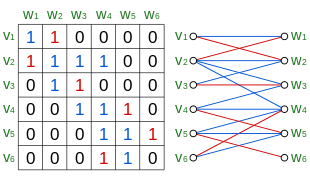Bregman–Minc inequality
In discrete mathematics, the Bregman–Minc inequality, or Bregman's theorem, allows one to estimate the permanent of a binary matrix via its row or column sums. The inequality was conjectured in 1963 by Henryk Minc and first proved in 1973 by Lev M. Bregman.[1][2] Further entropy-based proofs have been given by Alexander Schrijver and Jaikumar Radhakrishnan.[3][4] The Bregman–Minc inequality is used, for example, in graph theory to obtain upper bounds for the number of perfect matchings in a bipartite graph.
Statement
The permanent of a square binary matrix of size with row sums for can be estimated by
The permanent is therefore bounded by the product of the geometric means of the numbers from to for . Equality holds if the matrix is a block diagonal matrix consisting of matrices of ones or results from row and/or column permutations of such a block diagonal matrix. Since the permanent is invariant under transposition, the inequality also holds for the column sums of the matrix accordingly.[5][6]
Application

There is a one-to-one correspondence between a square binary matrix of size and a simple bipartite graph with equal-sized partitions and by taking
This way, each nonzero entry of the matrix defines an edge in the graph and vice versa. A perfect matching in is a selection of edges, such that each vertex of the graph is an endpoint of one of these edges. Each nonzero summand of the permanent of satisfying
corresponds to a perfect matching of . Therefore, if denotes the set of perfect matchings of ,
holds. The Bregman–Minc inequality now yields the estimate
where is the degree of the vertex . Due to symmetry, the corresponding estimate also holds for instead of . The number of possible perfect matchings in a bipartite graph with equal-sized partitions can therefore be estimated via the degrees of the vertices of any of the two partitions.[7]
Related statements
Using the inequality of arithmetic and geometric means, the Bregman–Minc inequality directly implies the weaker estimate
which was proven by Henryk Minc already in 1963. Another direct consequence of the Bregman–Minc inequality is a proof of the following conjecture of Herbert Ryser from 1960. Let by a divisor of and let denote the set of square binary matrices of size with row and column sums equal to , then
The maximum is thereby attained for a block diagonal matrix whose diagonal blocks are square matrices of ones of size . A corresponding statement for the case that is not a divisor of is an open mathematical problem.[5][6]
See also
References
- ↑ Henryk Minc (1963), "Upper bounds for permanents of (0,1)-matrices", Bull. Amer. Math. Soc., 69: 789–791, doi:10.1090/s0002-9904-1963-11031-9
- ↑ Lev Bregman (1973), "Some properties of nonnegative matrices and their permanents", Soviet Math. Dokl., 15: 945–949
- ↑ Alexander Schrijver (1978), "A short proof of Minc's conjecture", J. Combin. Theory Ser. A, 25: 80–83, doi:10.1016/0097-3165(78)90036-5
- ↑ Jaikumar Radhakrishnan (1997), "An entropy proof of Bregman's theorem", J. Combin. Theory Ser. A, 77: 161–164, doi:10.1006/jcta.1996.2727
- 1 2 Henryk Minc (1984), Permanents, Encyclopedia of Mathematics and its Applications, 6, Cambridge University Press, pp. 107–109
- 1 2 Vladimir Sachkov (1996), Combinatorial Methods in Discrete Mathematics, Cambridge University Press, pp. 95–97
- ↑ Martin Aigner, Günter M. Ziegler (2015), Das Buch der Beweise (4. ed.), Springer, pp. 285–292
External links
- Robin Whitty. "Bregman's Theorem" (PDF; 274 KB). Theorem of the Day. Retrieved 19 October 2015.